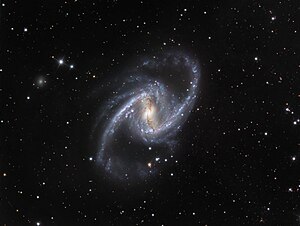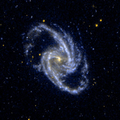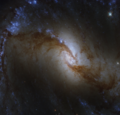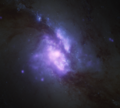NGC 1365
| Galaxy NGC 1365 |
|
|---|---|

|
|
| Taken with the Danish 1.5 m telescope in the La Silla Observatory | |
| AladinLite | |
| Constellation | Chemical furnace |
|
Position equinox : J2000.0 , epoch : J2000.0 |
|
| Right ascension | 03 h 33 m 36.4 s |
| declination | -36 ° 08 ′ 25 ″ |
| Appearance | |
| Morphological type | (R ') SBb (s) b Sy1.8 |
| Brightness (visual) | 9.5 likes |
| Brightness (B-band) | 10.3 mag |
| Angular expansion | 11 ′ × 6.2 ′ |
| Position angle | 32 ° |
| Surface brightness | 13.9 mag / arcmin² |
| Physical data | |
| Affiliation |
Fornax galaxy cluster , LGG 94 |
| Redshift | (5457 ± 3) · 10 −6 |
| Radial velocity | (1636 ± 1) km / s |
|
Stroke distance v rad / H 0 |
(68 ± 5) x 10 6 ly (20.7 ± 1.5) Mpc |
| Absolute brightness | −20 likes |
| Dimensions | approx. 3.9 · 10 11 M ☉ |
| diameter | approx. 160,000 ly |
| history | |
| discovery | James Dunlop |
| Discovery date | November 24, 1826 |
| Catalog names | |
| NGC 1365 • PGC 13179 • ESO 358-G017 • MCG -06-08-26 • IRAS 03317-3618 • SGC 033141-3618.4 • VV 825 • GC 731 • h 2552 • Dun 562 • HIPASS J0333-36 • LDCE 0249 NED015 | |
NGC 1365 is a bar-spiral galaxy of the Hubble type SBb in the constellation Fornax in the southern sky . The shape of the bars is striking and it is one of the best-known bar spiral galaxies. NGC 1365 has a magnitude of 9.5 mag and an angular extent of 11 ′, 0 × 6 ′, 2. The galaxy is about 68 million light years away and over 200,000 light years in diameter . NGC 1365 is a type 2 Seyfert galaxy and is one of the Fornax - galaxy clusters to. Seen from the earth, it rotates clockwise; a complete revolution takes about 350 million years.
The astronomers are particularly interested in the complex movement of interstellar matter in the galaxy and how it influences the gas reserves from which new stars then emerge. The huge bar causes disturbances in the galaxy's gravitational field, which compresses gas in certain areas and thereby stimulates star formation . Countless young star clusters can be seen in the spiral arms , each containing hundreds or thousands of young and bright stars, all of which were formed within the last ten million years.
As is common with spiral galaxies, the center of NGC 1365 is a black hole . By a lucky coincidence (a gas cloud pushed into the line of sight between the earth and the center of the galaxy) recently , the X-ray radiating gas disk around the black hole was measured using the Chandra X-ray telescope stationed in space . According to the measurement, the gas disk has a diameter of 7 AU , which corresponds to only ten times the calculated event horizon . So far, four supernovae have been observed in NGC 1365 : SN 1957C (type unknown), SN 1983V (type Ic), SN 2001du (type II-P) and SN 2012fr (type Ia).
The object was discovered on November 24, 1826 by the Scottish astronomer James Dunlop .
Ultraviolet image recorded with GALEX
Recorded in the visible spectrum using the Very Large Telescope
Central area of NGC 1365 as captured by the Hubble Space Telescope
X-ray radiation from the center imaged using the Chandra X-ray telescope
Web links
- Galaxy NGC 1365 in the media
- ESO: Elegant galaxy in an unusual light (+ photos, map & animation) September 22, 2010
- ESO: Inside the glow furnace (+ map, photos & animation) April 13, 2016
- Spektrum.de : Amateur recordings [1]
- SIMBAD Astronomical Database






